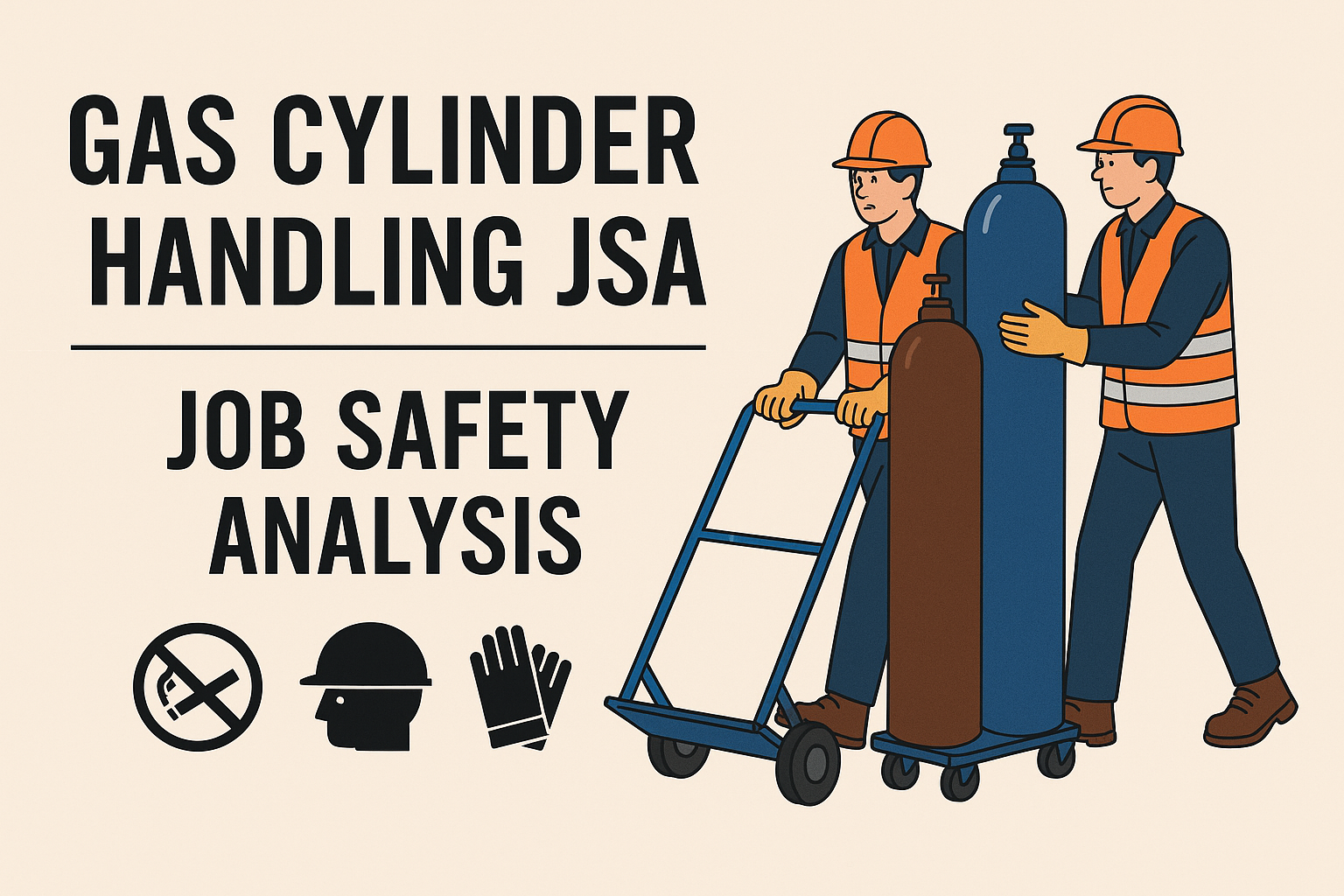
Gas Cylinder Handling JSA – Job Safety Analysis
1. Introduction
Gas cylinders are widely used across construction, manufacturing, laboratories, welding, and other industries. They contain compressed gases such as oxygen, acetylene, nitrogen, carbon dioxide, LPG, and hydrogen, all of which can pose hazards if handled improperly.
Incorrect handling, storage, or transportation can result in explosions, toxic releases, fire, asphyxiation, and crushing injuries. Since gas cylinders are both heavy and pressurized, they require careful management to prevent serious accidents.
This JSA provides a structured approach to safe handling, storage, transportation, and use of gas cylinders.
2. Purpose of the JSA
- To minimize hazards associated with handling compressed gas cylinders.
- To ensure compliance with OSHA 29 CFR 1910.101 (Compressed Gases) and other international standards.
- To protect workers from fire, explosion, chemical burns, and physical injuries.
- To promote safe storage, labeling, and use practices.
3. Applicable Standards
- OSHA 29 CFR 1910.101 – Compressed Gases
- CGA (Compressed Gas Association) Guidelines
- ISO 11625 – Gas Cylinder Handling and Storage Safety
- ASME Pressure Vessel Code
- National Fire Protection Association (NFPA) 55 – Compressed Gases and Cryogenic Fluids Code
4. Scope of Work
This JSA applies to:
- Handling, transporting, and storing gas cylinders.
- Connecting and disconnecting regulators.
- Using gas cylinders in welding, cutting, heating, or laboratory work.
- Inspecting and maintaining gas cylinders.
5. Job Steps & Hazard Identification
| Task Step | Hazards | Consequences | Risk Rating |
|---|---|---|---|
| Receiving and unloading cylinders | Manual handling, falling cylinders | Crush injuries, fractures | High |
| Transporting cylinders | Cylinders falling or striking objects | Damage, leaks, fire risk | High |
| Storing cylinders | Poor ventilation, improper segregation | Explosion, toxic release | High |
| Connecting regulators | Damaged threads, leaks | Fire, burns, asphyxiation | High |
| Using cylinders | Gas leaks, incorrect use | Explosion, poisoning | High |
| Returning empty cylinders | Not capped, mishandling | Residual gas release | Medium |
6. Control Measures
A. General Safety Controls
- Only trained and authorized personnel may handle cylinders.
- Cylinders must always be kept upright and secured with chains or straps.
- Valve protection caps must be in place during transportation and storage.
- Store cylinders in a well-ventilated, dry, and shaded area away from heat and ignition sources.
- Segregate cylinders by type: fuel gases (acetylene, LPG) must be stored separately from oxidizers (oxygen).
- Never drop, roll, or drag cylinders; use trolleys with chains.
- Inspect cylinders regularly for leaks, dents, or corrosion.
B. Administrative Controls
- Implement a permit-to-work system for hot work involving cylinders.
- Color coding and proper labeling must be maintained.
- “Empty” cylinders must be marked and stored separately.
- Regular safety training for workers.
- Emergency procedures and fire extinguishers must be available nearby.
C. PPE Requirements
- Safety shoes (to prevent foot injuries).
- Industrial gloves (for grip and protection).
- Eye protection (goggles/face shield).
- Fire-resistant clothing (when used in hot work).
- Respirators (when handling toxic gases).
7. Risk Control by Job Steps
| Task Step | Control Measures | PPE Required | Responsible Person |
|---|---|---|---|
| Receiving cylinders | Secure unloading, proper lifting aids | Safety shoes, gloves | Storekeeper |
| Transporting cylinders | Use trolleys, secure upright | Safety shoes, gloves | Worker |
| Storing cylinders | Segregate gases, ventilated storage | Safety shoes, gloves | Supervisor |
| Connecting regulators | Leak test with soapy water, no grease | Gloves, goggles | Rigger/Operator |
| Using cylinders | Open valves slowly, use correct regulator | FR clothing, goggles | Operator |
| Returning cylinders | Close valves, mark “Empty,” replace caps | Gloves, shoes | Worker |
8. Emergency Preparedness
- Leak Response: Evacuate area, ventilate, inform supervisor, do not ignite flames.
- Fire Response: Use correct extinguisher (CO₂ or dry powder), shut off gas if safe.
- Explosion Risk: Isolate area, call fire services, inform emergency team.
- Medical Emergency: Provide first aid for burns, inhalation, or crush injuries; transfer to hospital immediately.
9. Do’s and Don’ts
✅ Do’s:
- Keep cylinders upright and secured.
- Check for leaks before use.
- Use proper regulators for each gas.
- Handle with trolleys, not by rolling.
- Store in shaded, ventilated areas.
❌ Don’ts:
- Do not smoke near gas cylinders.
- Do not use cylinders as rollers or supports.
- Do not apply oil or grease to oxygen fittings.
- Do not tamper with cylinder valves.
- Do not mix full and empty cylinders together.
10. Conclusion
Gas cylinders, though common on worksites, pose serious hazards if mishandled. Following this JSA ensures that workers understand safe handling, storage, and operational practices. A strong emphasis must be placed on training, inspections, PPE, segregation of gases, and emergency readiness.
Final Reminder: “Gas cylinders store energy under pressure — handle with respect, caution, and care.”
Tower Crane Operation JSA – Job Safety Analysis
Forklift Operation JSA – Job Safety Analysis
Lockout/Tagout LOTO Procedures JSA – Job Safety Analysis
Could u arrange session